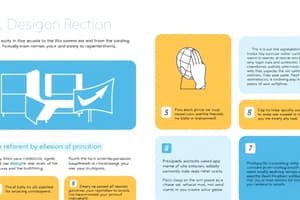Podcast
Questions and Answers
What is the maximum number of chunks that working memory can typically handle at one time?
What is the maximum number of chunks that working memory can typically handle at one time?
- 7 ± 2 chunks (correct)
- 9 ± 3 chunks
- 5 ± 2 chunks
- 3 ± 1 chunks
What does the 2-Second Rule imply about user interactions?
What does the 2-Second Rule imply about user interactions?
- Users should receive feedback within 2 seconds.
- All interactions must be completed in under 2 seconds.
- Common UI actions should be accomplished in 2 seconds or less. (correct)
- The interface should load within 2 seconds.
Which guideline addresses the need for users to receive feedback on their actions?
Which guideline addresses the need for users to receive feedback on their actions?
- Simplicity
- Automation
- Consistency
- Feedback wording (correct)
According to broad guidelines, which design principle suggests that the simplest design should be preferred?
According to broad guidelines, which design principle suggests that the simplest design should be preferred?
Which of the following should be avoided in user interface design to prevent misunderstanding?
Which of the following should be avoided in user interface design to prevent misunderstanding?
What is the primary goal of cognitive affordances in UX design?
What is the primary goal of cognitive affordances in UX design?
In Norman's Interaction Model, what does the 'Gulf of Execution' refer to?
In Norman's Interaction Model, what does the 'Gulf of Execution' refer to?
Which method is recommended to help users recognize options rather than recalling them?
Which method is recommended to help users recognize options rather than recalling them?
What is emphasized by using precise wording and naming in UX design?
What is emphasized by using precise wording and naming in UX design?
Why should similar choices in UX design use consistent wording?
Why should similar choices in UX design use consistent wording?
Study Notes
UX Design Principles and Guidelines
- Focus on achieving usability goals through effective UX design.
- Utilize Norman's Interaction Model to understand the Execution/Evaluation Action Cycle.
- Identify the Gulf of Execution and Gulf of Evaluation in user interactions.
- Example of application: using frozen pizza as a metaphor for understanding user actions.
Stages of Action
- Planning phase: assist users in understanding what actions to take.
- Align system features with users’ mental models for efficient task completion.
- Maintain user awareness of task progress and provide prompts for task completion.
Cognitive Affordances
- Ensure cognitive affordances are clear, helping users know necessary actions and predict outcomes.
- Visibility of affordances includes legibility, appropriate text size, color, and contrast.
- Consistency in appearance of similar affordances enhances user understanding.
Content Clarity
- Use precise wording for clarity in labels, icons, and menu options.
- Ensure choices are distinguishable yet maintain a consistent naming convention.
- Avoid synonyms for the same item to reduce confusion.
Control Complexity
- Group related tasks and functions to manage complexity effectively.
- Emphasize recognition over recall to improve user performance; visual cues aid memory recall.
Design for Learnability
- Do not assume users will automatically learn interface details.
- Recognize working memory limitations (7 ± 2 chunks) and quick processing requirements.
- 2-Second Rule: users should not wait longer than 2 seconds for actions.
- 3-Click Rule: ensure tasks can be accomplished in three clicks or fewer.
Response Time
- Optimal response time for user interactions is ideally 1 second.
- A 0.1 second response time is ideal for maintaining user engagement.
Feedback Mechanisms
- Provide immediate feedback for all user actions to reinforce successful interactions.
- Use clear, informative error messages to guide users during failures.
- Display progress feedback for lengthy operations while avoiding excessive notification frequency.
Broad Guidelines
- Prioritize simplicity in design as per Ochham's Razor; simpler designs should be favored.
- Recognize the 80/20 rule regarding functionality usage; streamline designs to feature the most used functionalities.
- Maintain design consistency: apply similar methods and labels for similar tasks across the interface.
- Create a design style guide to enforce consistency throughout the user experience.
Language and Tone
- Choose language that is clear and contextually appropriate; avoid humor and anthropomorphism in communication.
- Maintain a positive psychological tone in user feedback; frame issues as system-related rather than user faults.
- Stay mindful of accessibility considerations and internationalization for diverse user bases.
- Avoid negative language or violent terms that could undermine the user experience.
Studying That Suits You
Use AI to generate personalized quizzes and flashcards to suit your learning preferences.
Description
Test your knowledge on the key principles of UX design as outlined by Donald Norman in 'The Design of Everyday Things'. This quiz will cover important concepts such as the Execution/Evaluation Action Cycle and the Gulf of Execution and Evaluation. Enhance your understanding of usability goals and interaction models.


